CNIO is developing a new model of the epigenetic clock that offers more precise measurements.

One of the most used tools today for measuring body deterioration over time is the so-called “epigenetic clock.” Epigenetics refers to the chemical modifications that cells’ DNA accumulates throughout life; It is known that you…
One of the most used tools today for measuring body deterioration over time is the so-called “epigenetic clock.” Epigenetics refers to the chemical modifications that cells’ DNA accumulates throughout life; These changes are known to change with age and are actually an indicator of aging. Just over a decade ago, a pattern of epigenetic changes correlated with aging in various organs was discovered, and epigenetic clocks began to be used to measure the progress of this process.
Epigenetic age greater than chronological age (a person’s lifespan) is associated with a higher risk of disease and mortality. The biology underlying the epigenetic clock—the relationship between epigenetic changes and disease—is still not well understood, but the epigenetic clock is believed to actually measure critical biological processes.
“The epigenetic clock has not only highlighted the potential of epigenetic changes as a biomarker of aging, but also represents a valuable tool for studying many pathologies.”write researchers from the National Center for Cancer Research (CNIO) Miguel Quintela and Leonardo Garma.
Both are now publishing a study in the journal Genome Medicine in which they find significant inaccuracies in the most commonly used epigenetic clocks and warn that these tools are affected by the problem of “out of step technologies.” To solve this problem, they developed a new model of the epigenetic clock that offers more precise measurements.
“Epigenetic age” of breast cancer patients
Quintela directs CNIO’s Breast Cancer Clinical Research Unit, which is leading the Digital Twins project to create virtual models of cancer patients (models that will hopefully lead in the future to the best treatment for each patient). The team thought it would be interesting to include patients’ epigenetic age in the model, and turned to their familiar epigenetic clock.
Several studies have shown that tissue epigenetic age may be related to cancer. “In cancer, accelerated epigenetic age (exceeding chronological age) is associated with an increased risk of developing breast and colon cancer.”write to Quintel and Garm in Genomic Medicine. It has also been observed that the breast tissue of breast cancer patients suffers from epigenetic aging, more severely the more intensive their treatment.
But when using epigenetic clocks, CNIO researchers found variations in results by an average of 3 years, and up to 25 years in some epigenetic clocks used.
Mathematical models
In practice, epigenetic clocks are mathematical models that interpret data provided by DNA analysis devices, DNA chips. According to the CNIO researchers, the inaccuracies in the results are explained by the fact that existing epigenetic clocks take into account points in the genome that are not represented in the DNA chips currently used. “It’s a matter of technological evolution”says Garma, first author of the study.
The new epigenetic clock model developed by CNIO researchers actually adapts to the latest available version of DNA chips. They confirmed that the difference between measurements from the same and different subjects was less than one year. “This means it is a reliable and accurate model.”– says Garma.
Population-scale health indicator?
This is important because “There has been talk that these models might reflect pathological conditions, but here we see that this is highly questionable: if we want to use them to assess differences between, for example, a diseased subject and a person with cancer, we will have to take into account this noise, which may lead to age differences in results.”indicates the first author of the article.
Moreover, Garma adds: “It may not matter to an individual that the biological age is 3 years older. But in populations it is. If, for example, the epigenetic age of a group of smokers is 3 years older than that of the non-smoking population, then “These data may be important in order to to draw conclusions about the health effects of tobacco.”
